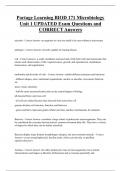Portage Learning BIOD 171 Microbiology
Unit 1 UPDATED Exam Questions and
CORRECT Answers
microbe - Correct Answer- an organism or virus too small to be seen without a microscope
pathogen - Correct Answer- microbe capable of causing disease
cell - Correct Answer- a small, membrane enclosed unit of life built with macromolecules that
retains each characteristic of life: responsiveness, growth, and reproduction, metabolism,
homeostasis, and organization
uniformity and diversity of cells - Correct Answer- exhibit different structures and functions
- different shapes, sizes, nutritional requirements, aerobic or anerobic, movement, behavior,
etc.
share a basic chemistry
- built by same macromolecules and use the central dogma of biology
all descend from a previous cell
- all cells are related because they descend from a previous cell
genome dictates cell structure, function, and behavior
- genes and their expression guide cellular activities and have mechanisms for mutation
Bacteria - Correct Answer- constitute a large cohort of prokaryotic microorganisms. They can
be considered the everyday bacteria and are common in human daily life. They have a variety
of shapes by which they can be further classified.
Bacteria display many distinct morphologies (shapes), the most common include: - Correct
Answer- coccus (round/spherical), bacillus (rod), vibrio (curved rod), or spirillum
(spiral/corkscrew).
Archaea - Correct Answer- the other prokaryotic class of microorganisms, have similar
characteristics and shapes as Bacteria (Eubacteria) and yet remain genetically and
, compositionally distinct. Most notably, they can survive in extremely harsh environmental
conditions, such as high salt levels, acid conditions, high temperatures, and oxygen-poor
conditions. As such, Archaeons may also be referred to as extremophiles, based on the
extreme or atypical environments in which they can be found.
Eukarya - Correct Answer- is a diverse category and consists of a wide range of
microorganism. Due to high diversity and complexity, eukaryotes can be subdivided into
multiple categories, a process still debated today. However, the unifying characteristic of all
eukaryotic cells is the presence of a membrane-bound nuclear region within the cell. For the
purposes of this course, eukaryotic microorganisms will be classified as either: Animalia,
Plantae, Fungi, and Protista.
Animalia - Correct Answer- consists of multicellular eukaryotic organisms, and, as the name
suggests, includes animals, as well as humans (and their cells) in their classification. All
microorganisms in this category are heterotrophic , meaning they are incapable of producing
their own energy, must absorb (consume) nutrients from the environment, and have the
general characteristic of motility (the ability to move).
heterotrophic - Correct Answer- meaning they are incapable of producing their own energy,
must absorb (consume) nutrients from the environment, and have the general characteristic of
motility (the ability to move).
Plantae - Correct Answer- are also multicellular eukaryotes, but, unlike Animalia, they can
obtain most of their energy from sunlight via photosynthesis—a process that converts light
energy (sunlight) into chemical energy (sugars) within the organism and fuels its activities.
Fungi - Correct Answer- can be either multicellular or unicellular microorganisms, and, like
Animalia, they are heterotrophic. A defining characteristic of fungi is the presence of chitin, a
derivative of glucose, in their cell walls. Common examples of multicellular fungi are molds
and mushrooms, while perhaps the most common unicellular fungus is yeast.
Protista - Correct Answer- are unicellular microorganisms that may form as colonies.
However, the colonies (seemingly multicellular) do not form tissue layers and thus retain the
unicellular classification. Protista is often used as a classification for any microorganism that
does not clearly fit the criteria for being considered animal, plant, or fungi. Common
examples range from amoeba, known for its motility; algae, known for its plant-like
characteristics; and mold, known for its fungi-like properties.




